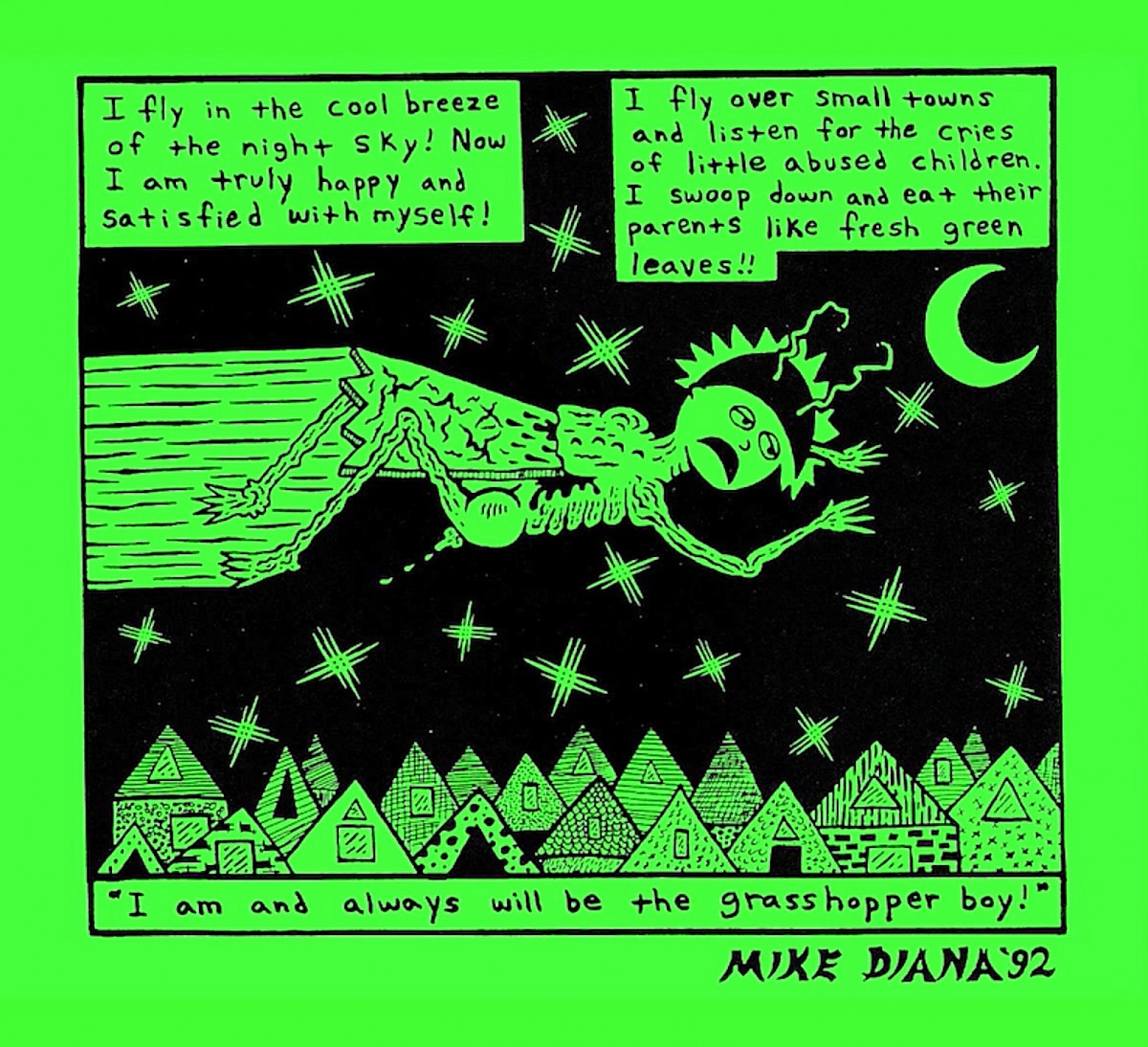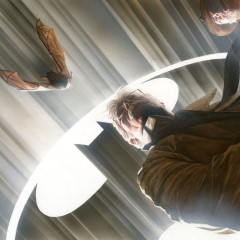BOILED ANGELS: THE TRIAL OF MIKE DIANA

“In 1954, a psychologist testified that reading comic books would turn children into juvenile delinquents. In 1994, a psychologist testified that reading Boiled Angel would turn adults into serial killers,” narrates punk rock mouthpiece Jello Biafra in Frank Henenlotter’s new documentary Boiled Angels: The Trial of Mike Diana, which will be having its international premiere this Saturday as part of Montreal’s Fantasia Film Festival.
At 24 years old, Largo, Florida, cartoonist Mike Diana, creator of DIY zine Boiled Angel, became the first American artist convicted of obscenity. He spent four days and four nights in jail immediately following the verdict, only to later find out from his lawyer that the judge didn't actually have to throw him in the slammer, but just wanted to make an example of him. Opportunistic prosecutor, Stuart Baggish, vindictively continued to push for three years jail time because he felt the publicity had made Diana a famous artist. “The county does not have to accept what is acceptable in the bathhouses of San Francisco and the crack alleys of New York,” he argued. In the end, Diana’s final sentencing consisted of three years probation, a three-thousand dollar fine, 1200 hours of community service, and an order to pay 1200 dollars for his own psychiatric evaluation, find a forty-hour a week full-time job, take and pass a journalism ethics course, and stay at least ten feet away from anyone under eighteen years of age. He was also forbidden to draw anything considered obscene even for his own personal use in the privacy of his own home, and was subject to warrantless searches by police.
All of this just for scratching out his patented brand of darkly humorous Keith Haring meets Herschell Gordon Lewis dirty pictures for fellow fans and colleagues. As the late classic underground cartoonist Jay Lynch, one of the many comic luminaries that appear as commentators in the film, quipped: “One step away from cutting off his hands.”

The late film director George Romero also put in his two-cents worth, making parallels with the EC horror comics of the 50’s that so influenced him as a child and were taken away from him after pop psychiatrist Dr. Frederick Wertham made a campaign of pointing out how supposedly bad an influence they were on children. The U.S. Senate listened, the book burnings began, and a Comics Code Authority was established as an industry censor. Comic books without their seal of approval on the cover were doomed, which included all the EC horror titles. EC’s satirical comic book, Mad, was forced to change into a magazine without the code and survives to this day. Among those disgruntled EC fans jonesing for unfettered entertainment were a few burgeoning artists who grew into adulthood just in time for the 60’s free-speech movement, testing the limits of freedom of expression by unleashing their darkest taboo-breaking fantasies, as if to get revenge on the censorious tactics of the 50’s, all while maintaining a strong satirical element.
Mike Diana picked up on these counterculture comics when he saw an ad selling discount “grab bags” of old undergrounders in the back pages of Heavy Metal Magazine in the 80’s, and was strongly influenced, believing the complete artistic freedom they enjoyed was also his to enjoy and he decided to up the ante. He thought wrong. Cartoonist Peter Bagge offers that as the 60’s and 70’s undergrounds evolved into the 80’s as “alternative comics” with adult themes, it was too soon for most of America, who thought comics were still only meant for kids, and to include adult content in them meant you were trying to “subvert their children.” Child sex abuse hysteria in the media at the time exacerbated the situation. It was bad timing for Mike Diana.

Diana fled Florida without telling his lawyer, sneaking away in the middle of his appeal. But despite settling in New York City, his probation officer continued to call him from Florida to remind him not to draw. And the authorities in Florida wanted him back for probation, even trying to get NYC’s law enforcement offices to take the case, but NYC wanted nothing to do with it. Author Neil Gaiman’s bewilderment is palpable as he chalks it up to small town mentality, “New York cops are too busy to knock down someone’s door at 4:00 am and make sure they’re not drawing.” Gaiman believes this case should be taught in every school. Diana has been wanted by Florida police since 1998, and as a result, hasn’t been able to visit family and friends back home for decades. His consternation continues to this day as evidenced by one rattling scene where he’s being filmed discussing his plight in front of his old hometown courthouse, registering genuine paranoia as a dark car suspiciously, slowly swishes past. Diana suspects he and the film crew are being followed by detectives.
Mike Diana grew up in Upstate New York where his biggest offence was handing in a nude drawing of his family as an art project in kindergarten and being told to clothe them. He felt like an outsider after the family moved to Florida when he was eight. In Florida, teachers used paddles to punish their students, he witnessed racism for the first time, and his family’s new church preached fire & brimstone with excruciatingly gory descriptions of the crucifixion. At the same time, the local TV news would broadcast church cover-ups of child molestations. Living in Florida made his art more extreme. “All these problems that I saw around me, a lot of them were being ignored, not enough was being done about these things,” Diana explains to a TV talk show host in the midst of his media frenzy, “I wanted to use my art to express my anger that these things were going on.” A caller begs to differ and offers that Diana’s inspiration was Satan. “In real life I detested violence,” Diana says. Cartoonist Peter Kuper was asked by the Comic Book Legal Defence Fund to fly down to testify as a defence witness, and acknowledged that while chilling out watching the local Florida news it dawned on him that this was where Diana’s source material came from.

A lifelong horror film enthusiast, Diana made his own gory home movies at a young age with crude special effects starring friends & family members, several charming excerpts of which are included in Boiled Angels. His supportive mom nostalgically reminisces about the time she offered her services as a victim. Cue the decapitation footage. When the physical requirements of film-making became too cumbersome, Diana switched to the more sensibly budgeted medium of cartooning, producing B&W photocopied horror comics with minuscule print runs, largely intended for trade with other like-minded adult artists around the globe during the pre-internet DIY mail-art zine movement of the 80’s and 90’s.
Eventually, a copy of Diana’s Boiled Angel accidentally landed in a highway patrol cop’s hands in California. Aghast at the graphic violence contained within, he mailed it back to the authorities in Florida, who were in the middle of investigating a serial killer whose handiwork they claim Diana’s comics resembled. A blood test proved him innocent, but nonetheless they thought something needed to be done about the phenomenon and decided to pool their resources towards saving Diana from himself, charging him with distributing obscene materials.
The local media storm that ensued blurred the distinctions between Florida’s ongoing serial killer coverage and the outrage over Diana’s horror comics to the point where he was being accosted by strangers on the street mistaking him for the serial killer. Members of Concerned Women of America and religious groups noisily prayed for his soul while picketing his presence, especially when the news cameras were on. Such priceless footage abounds in Boiled Angels, along with numerous hilarious, albeit depressing excerpts from Oprah wannabes trying to crack open what made the cartoonist tick, exemplifying the “Satanic Panic” era of the time. As Fantasia Film Festival programmer Mitch Davis asserts, “If you care at all about reactionary police overreach in culture and art - no small concern as the Western world veers creepily towards the extreme right - this is a film you need to see.”
Screening Saturday July 14, 5:05 PM and Wednesday July 18, 2018, 12:30 PM at Concordia’s Salle J.A. De Sève theatre hosted by director Frank Henenlotter (Basket Case, Brain Damage), producer Mike Catalano, and subject Mike Diana as part of Montreal’s Fantasia International Film Festival. Tickets available at fantasiafestival.com.
Rick Trembles,
Friday the 13th, July 2018






